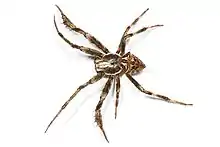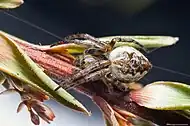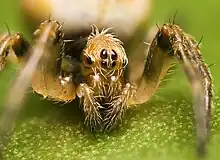| Eriophora | |
|---|---|
 | |
| Eriophora nephiloides from Belmopan, Belize | |
 | |
| Eriophora heroine | |
| Scientific classification | |
| Domain: | Eukaryota |
| Kingdom: | Animalia |
| Phylum: | Arthropoda |
| Subphylum: | Chelicerata |
| Class: | Arachnida |
| Order: | Araneae |
| Infraorder: | Araneomorphae |
| Family: | Araneidae |
| Genus: | Eriophora Simon, 1864[1] |
| Type species | |
| E. ravilla (C. L. Koch, 1844) | |
| Species | |
|
7, see text | |
| Synonyms[1] | |
| |
Eriophora is a genus of orb-weaver spiders first described by Eugène Simon in 1895.[3] It occurs in the Americas, Australasia, and Africa. The name is derived from Ancient Greek roots, and means "wool bearing".[4]
Species
Most species now grouped here have been classified as Araneus at some time in their description history. As of July 2022 Eriophora contains seven species:[1]
- Eriophora conica (Yin, Wang & Zhang, 1987) – China
- Eriophora edax (Blackwall, 1863) – USA to Brazil
- Eriophora fuliginea (C. L. Koch, 1838) – Honduras to Brazil
- Eriophora nephiloides (O. Pickard-Cambridge, 1889) – Guatemala to Guyana
- Eriophora neufvilleorum (Lessert, 1930) – Congo, Ethiopia
- Eriophora pustulosa (Walckenaer, 1841) – Australia, Tasmania, New Zealand
- Eriophora ravilla (C. L. Koch, 1844) – USA to Brazil
Gallery
 Flame-bellied or orange-bellied orb-weaver, Osa Peninsula, Costa Rica
Flame-bellied or orange-bellied orb-weaver, Osa Peninsula, Costa Rica Either Eriophora heroine or Eriophora pustulosa
Either Eriophora heroine or Eriophora pustulosa Portrait of Eriophora heroine or Eriophora pustulosa
Portrait of Eriophora heroine or Eriophora pustulosa Eriophora ravilla, Florida
Eriophora ravilla, Florida
References
- 1 2 3 "Gen. Eriophora Simon, 1864". World Spider Catalog. Natural History Museum Bern. Retrieved 14 July 2022.
- ↑ Levi, H. W. (2002). "Keys to the genera of araneid orbweavers (Araneae, Araneidae) of the Americas". Journal of Arachnology. 30 (3): 562. doi:10.1636/0161-8202(2002)030[0527:KTTGOA]2.0.CO;2. S2CID 84360673.
- ↑ Simon, E (1895). Histoire naturelle des araignées. doi:10.5962/bhl.title.51973.
- ↑ "Genus Eriophora". BugGuide. Retrieved 2019-05-13.
External links
Wikispecies has information related to Eriophora.
Wikimedia Commons has media related to Eriophora.
- Eriophora ravilla, a tropical orb weaver spider on the UF / IFAS Featured Creatures Web site
This article is issued from Wikipedia. The text is licensed under Creative Commons - Attribution - Sharealike. Additional terms may apply for the media files.